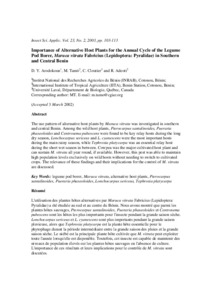| dc.contributor.author | Arodokoun, D. |
| dc.contributor.author | Tamo, M. |
| dc.contributor.author | Cloutier, C. |
| dc.contributor.author | Adeoti, R. |
| dc.date.accessioned | 2020-01-15T13:05:26Z |
| dc.date.available | 2020-01-15T13:05:26Z |
| dc.date.issued | 2003-06 |
| dc.identifier.citation | Arodokoun, D., Tamo, M., Cloutier, C. & Adeoti, R. (2003). Importance of Alternative Host Plants for the Annual Cycle of the Legume Pod Borer, Maruca vitrata Fabricius (Lepidoptera: Pyralidae) in Southern and Central Benin. Insect Science and Its Application, 23, 103-113. |
| dc.identifier.uri | https://hdl.handle.net/20.500.12478/6688 |
| dc.description.abstract | The use pattern of alternative host plants by Maruca vitrata was investigated in southern and central Benin. Among the wild host plants, Pterocarpus santalinoides, Pueraria phaseoloides and Centrosema pubescens were found to be key relay hosts during the long dry season, Lonchocarpus sericeus and L. cyanescens were the most important hosts during the main rainy season, while Tephrosia platycarpa was an essential relay host during the short wet season in between. Cowpea was the major cultivated host plant and can sustain M. vitrata all year round, if available. However, this pest was able to maintain high population levels exclusively on wild hosts without needing to switch to cultivated crops. The relevance of these findings and their implications for the control of M. vitrata are discussed.
L'utilisation des plantes hôtes alternatives par Maruca vitrata Fabricius (Lepidoptera: Pyralidae) a été étudiée au sud et au centre du Bénin. Nous avons montré que parmi les plantes hôtes sauvages, Pterocarpus santalinoides, Pueraria phaseoloides et Centrosema pubescens sont les hôtes les plus importants pour l'insecte pendant la grande saison sèche. Lonchocarpus sericeus et L. cyanescens sont plus importants pendant la grande saison pluvieuse, alors que Tephrosia platycarpa est la plante hôte essentielle pour le phytophage durant la période intermédiaire entre la grande saison des pluies et la grande saison sèche. Le niébé est la principale plante hôte cultivée que M. vitrata peut exploiter toute l'année lorsqu'elle est disponible. Toutefois, cet insecte est capable de maintenir des niveaux de population élevés sur les plantes hôtes sauvages en l'absence de culture. L'importance de ces résultats et leurs implications pour le contrôle de M. vitrata sont discutées. |
| dc.format.extent | 103-113 |
| dc.language.iso | en |
| dc.subject | Host Plants |
| dc.subject | Legumes |
| dc.subject | Maruca Vitrata |
| dc.title | Importance of Alternative Host Plants for the Annual Cycle of the Legume Pod Borer, Maruca vitrata Fabricius (Lepidoptera: Pyralidae) in Southern and Central Benin |
| dc.type | Journal Article |
| cg.contributor.affiliation | International Institute of Tropical Agriculture |
| cg.authorship.types | CGIAR single centre |
| cg.iitasubject | Grain Legumes |
| cg.iitasubject | Pests Of Plants |
| cg.journal | Insect Science and Its Application |
| cg.accessibilitystatus | Limited Access |
| cg.reviewstatus | Peer Review |

